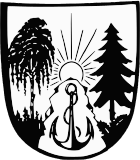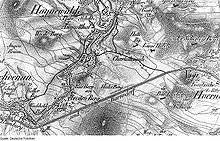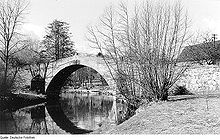Hainewalde
| coat of arms | Germany map | |
|---|---|---|

|
Coordinates: 50 ° 54 ' N , 14 ° 42' E |
|
| Basic data | ||
| State : | Saxony | |
| County : | Goerlitz | |
| Management Community : | Großschönau-Hainewalde | |
| Height : | 322 m above sea level NHN | |
| Area : | 12.96 km 2 | |
| Residents: | 1511 (Dec. 31, 2019) | |
| Population density : | 117 inhabitants per km 2 | |
| Postal code : | 02779 | |
| Area code : | 035841 | |
| License plate : | GR, LÖB, NOL, NY, WSW, ZI | |
| Community key : | 14 6 26 170 | |
| LOCODE : | DE HIW | |
| Address of the municipal administration: |
Kleine Seite 04 02779 Hainewalde |
|
| Website : | ||
| Mayor : | Jürgen Walther (independent) | |
| Location of the municipality of Hainewalde in the district of Görlitz | ||
Hainewalde ( Upper Lusatian : Heenewaale ) is a Saxon municipality in the district of Görlitz . It is located near the German- Czech border and belongs to the Großschönau-Hainewalde administrative community .
Geography and traffic
The community Hainewalde is located in the south-western part of the district. It is located about ten kilometers west of Zittau in the foreland of the Zittau Mountains and is traversed by the Mandau . To the south it borders on the Breiteberg in front of the Zittau Mountains , which is considered Hainewalde's local mountain .
The border with the Czech Republic runs to the west of the municipality . The community is located on the railway line Zittau-Varnsdorf , the station trains link the state railway (brand name " trilex ") towards Seifhennersdorf and Liberec is operated. The federal highway 96 runs north of the municipality in the Löbau – Zittau section.
history
Hainewalde was laid out as a Waldhufendorf village by the settlers along the Mandau Valley as part of the feudal German settlement in the east . The place was mentioned in a document in 1326 as "Heyninwalde". The place name is probably derived from the place founder "Hener", "Heno", "Hening" or "Heinrich".
In 1392 the old castle (gatehouse) was built as a manor.
During the Hussite Wars , the Hussites on the Breiteberg, where they passed with their large booty to Bohemia, were attacked by Zittauers hidden in the woods. 150 men were killed.
On September 20, 1546 Ulrich von Nostitz was enfeoffed with Hainewalde. After his death in 1552, his son Christoph von Nostitz (1533 to February 10, 1576) took over the rule.
In 1564 the construction of the old castle took place, which was partially demolished in 1780 and completely in 1845.
After the Peace of Prague , Upper Lusatia and thus Hainewalde fell to Saxony in 1636, although extensive concessions were made to independence and religious freedom. Around 1650 this attracted some Bohemian exiles who increased the population. They brought the hair floor weaving and screen production to Hainewalde and thus contributed to an economic upswing.
From 1749 to 1755, the Prussian chamberlain, Samuel Friedrich von Kanitz, had the New Palace built. It still rises impressively over a terraced mountainside today. In 1778 the Hainewalde property fell by way of succession to the von Kyaw family, who were related by marriage to the von Kanitz family and sold it to the community of Großschönau on March 12, 1927 .
On March 26, 1933, it was occupied by the guard of the SA-Sturmbannes III-102 from Dresden, which set up a temporary concentration camp for political prisoners in which between 450 and 1,000 prisoners were incarcerated and mistreated, especially the Jews . The first transports of prisoners arrived on March 28, 1933. On August 10, 1933, the Hainewalde concentration camp was dissolved again. After the Second World War it was used for various purposes. It has been empty since 1972 and is in ruins. In 2000 the “Friends of the Kanitz-Kyaw Castle Hainewalde e. V. “founded. In 2007, the renovation of the east wing started.
politics
(+43.9 % p )
(-33.2 % p )
(-4.5 % p )
(-6.2 % p )
In the local elections on May 25, 2014, the 18 seats of the municipal council were distributed among the individual parties and lists as follows:
| Hainewalde Citizens' Committee | CDU | Citizens for Hainewalde |
| 7 seats | 1 seat | 4 seats |
Culture and sights
see also: List of cultural monuments in Hainewalde
Attractions
- Half-timbered houses
- Church built from 1705 (laying of the foundation stone on April 15th) to 1711 (inauguration on October 7th) (construction closed from September 6th, 1706 to spring 1708 due to war riots, construction costs 11,064 Taler, 10 Groschen and 3½ Pfennig)
- Moated castle : In the northern part of the castle park is the gatehouse of the old castle built under the rule of the von Nostitz family. After the demolition in 1780, only the gate building with its renaissance portal on the west side of this former moated castle in roughly square shape with inner courtyard has been preserved.
- Hainewalde Castle : From 1749 to 1755 the New Castle was built together with the terraced baroque gardens under the rule of the von Kanitz-Kyaw family. In 1883 the castle was renovated and the exterior facade stripped of its baroque elements . Instead she received italizing sgraffiti .
- Baroque crypt of the Kanitz-Kyaw family in the cemetery from 1715
- The local mountain Breiteberg with observation tower, mountain chalet and Querx cave
- Roschertal downstream along the Mandau
- Himmelsbrücke, single arch bridge from 1832 over the Mandau
Memorials
A memorial stone at the entrance to the palace garden commemorates resistance fighters and victims of fascism .
Culture
There are several clubs in town. The Roaperradl , where cultural events are organized on a monthly basis , is known beyond the local borders .
Regular events
- Breed rabbit and poultry show
- Hainewald Christmas Market
economy
The beverage manufacturer Menschel-Limo is located in Hainewalde.
Personalities
- Gottlob Friedrich Seligmann (1654–1707), Lutheran theologian
- Daniel Neumann (1717–1783), pastor in Hainewalde from 1761 to 1783
- Karl August Wünsche (1838–1912), theologian and orientalist
- Helmut Kriegel (* 1923), trade unionist
literature
- Kirsten Krepelin, Thomas Thränert: Hainewalde Castle and Gardens . Ed .: Zittauer Geschichts- und Museumsverein e. VG Oettel, Görlitz 2010, ISBN 978-3-938583-54-8 .
- Kirsten Krepelin, Thomas Thränert: Hainewalde Castle and Park. The mansion as a monument. In: Lars-Arne Dannenberg, Kai Wenzel (ed.): Between mighty princes. The nobility in Upper Lusatia from a comparative perspective (16th to 19th centuries). G. Oettel, Görlitz / Zittau 2016, pp. 176–206.
- Falk Lorenz: Terraces and stairs. Hainewalde Castle Park . In: Ernst Panse (ed.): Park guide through Upper Lusatia . Lusatia Verlag, Bautzen 1999, ISBN 3-929091-56-9 , pp. 215-217.
- Monika Rössler (Ed.): Hainewalde in the valley of the Mandau. Geiger, Horb am Neckar 1994, ISBN 3-89264-957-X .
- The south-eastern Upper Lusatia with Zittau and the Zittau Mountains (= values of the German homeland . Volume 16). 2nd Edition. Akademie Verlag, Berlin 1971.
- Arthur Wündrich: The German screen- making and horsehair weaving mill in its historical development and its current situation, primarily in Hainewalde . Fritsche & Schmidt, Leipzig 1910.
- Cornelius Gurlitt : Hainewalde. In: Descriptive representation of the older architectural and art monuments of the Kingdom of Saxony. 29. Issue: Amtshauptmannschaft Zittau (Land) . CC Meinhold, Dresden 1906, p. 27.
Web links
- Official website of the Hainewalde community
- Hainewalde in the Digital Historical Directory of Saxony
Individual evidence
- ↑ Population of the Free State of Saxony by municipalities on December 31, 2019 ( help on this ).
- ^ Hainewalde: Old Hainewalde Castle. In: Sachsens-Schlösser.de. Retrieved March 31, 2014 .
- ^ Hainewalde: New Hainewalde Castle. In: Sachsens-Schlösser.de. Retrieved March 31, 2014 .
- ↑ 2014 municipal council elections . State Statistical Office of the Free State of Saxony , accessed on August 12, 2014 .
- ↑ Hainewald sights: The church. Retrieved March 31, 2014 .










